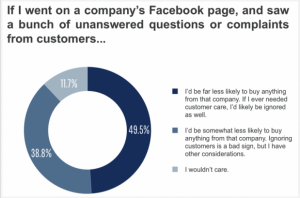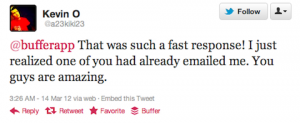Looking to build and strengthen customer relationships?
Your customers are everything as a brand.
Without customers, you wouldn’t be able to continue running your business.
Most brands put great effort into acquiring new customers, but there’s another strategy that has proven to be far more effective….
That is working to improve customer relationships.
A study found that it is 6-7 times more expensive to acquire a new customer than it is to keep a current one. That might come as a surprise to some, but when you think about it, it’s very obvious. Working to acquire new customers is a tough job, with marketing investments needed. And even then, it’s not sure that you’ll acquire any new customers.
With customer relationships, however, it’s a completely different ball game.
Today, with the internet and the infrastructure on the web, we can reach and interact with virtually anyone, anywhere in the world.
Since engaging and interacting is the foundation for improving customer relationships, even when working to improve customer relationship, this is great news, because it means we cause the internet and all the tools it offers, to interact with our customers in order to improve our relationships.
You probably have a few very loyal customers of your brand. Think about how you acquired those for a second.
Chances are, it was by going above and beyond, and providing them with immense value. Most likely, it was by interacting and engaging with them while doing so.
Relationships, no matter which type demands consistent interacting and engaging. To improve customer relationships, you, therefore, need to develop somewhat of a strategy which isn’t just centered around one-time actions, but rather interactions and conversations on a regular basis.
Not only is it more expensive to acquire new customers than to keep your existing ones, but loyal customers also tend to spend more. In fact, 7 in 10 Americans said they were willing to spend more with companies they believe provide excellent customer service. And that’s not all, either. Furthermore, the probability of selling to a new prospect is 5-20% wheres the profitability of selling to an existing customer is a whopping 60-70%.
What does this mean?
It means that if you’re working full force towards acquiring new customers, you’re missing out the immense benefits you get by working to improve customer relationships.
If you’re just acquiring new customers and not working to keep them once you’ve gotten them to the other side, it’s like trying to fill a bucket with water that has holes in the bottom.
I hope the statistics have spoken clearly that you need to improve customer relationships, and fortunately for you, how you do that is exactly what you’ll learn in this post.
1.Learn more about your customers
This is a big deal and ties together a lot with the psychology of human interaction.
You might have met someone who says things that make it feel like you’ve known them for your entire life. When they do, you tend to resonate with them a lot more, which contributes to a stronger relationship that is built faster.
Learning about your customers has many benefits which contribute to you ultimately building better customer relationships with them.
Firstly, when you know your customers, the more you can tailor your interaction with them. For example, chances are, that if you talk to one friend of yours, you might talk about things that interest them, but if you talk to someone else, you might talk about things that interest them. The huge benefit of doing this is not only that they’ll feel like they’ve known you for a longer time, but they’ll also feel more happy to engage and interact with you since they get to talk about things they’re passionate about. In order to do this as a brand, you obviously need to focus on learning more about your customers first. Of course, a great way to do just that is by actually engaging and interacting with them, but remember that we humans are sharing more information about ourselves than ever before, and so if you want to learn about your customers, social media is a goldmine to do just that.
Of course, there are a large number of ways you can learn about your customers, and frankly, you should be using all the methods you can. One of the most popular is lead-generation forms where you collect information about your prospects, but the fact is that that will only give you limited information about them. This is why I cannot emphasize just how powerful social media is for the sake of collecting information about your customers and prospects in order to be able to interact with them better.
The best part of learning about your customers is that you get a deeper understanding of their needs. As a result, you can, rather than try to shove ads in their face, present them with solutions to their problems within the conversation, that come across the right way and at the right time.
2. Never ignore your customers
In order to improve your customer relationships, you need to actually engage with your customers. Yet despite this, I see brands whose actions don’t back up their ambitions. They say that they want to improve their customer relationships, yet despite this, if you go to their social media pages, they have numerous of messages from customers that haven’t gotten responded to, and if you look at review sites, it’s the same story there.
How do you expect to improve your customer relationships if you only respond to some customer messages? How will you be able to build customer relationships when you only respond to customers when you feel like it?
The answer is, you can’t.
As a brand, you can’t be selective about which message you respond to and which messages you don’t! You need to take every single opportunity you get, no matter if it’s a furious customer, a disappointed customer, or a loyal fan giving praise.
If you don’t it means missing out on incredible opportunities.
There are two ways to build your customer relationships. Either by waiting for your customers to reach out to you and then responding to them and pursuing the conversation or, you actively going out and trying to start a conversation with them.
Which do you think is the easier?
The first mentioned of course because this means that you don’t have to actively go out and look for people who might be interested in your brand. Instead, they come to you. Yet, despite this, many brands miss out or neglect this tremendous opportunity where people just come to them.
Remember that people aren’t contacting you, whether it be on social media, email, phone, or anywhere else, because they don’t expect you to respond, right?
They contact you because they expect an answer, but if they don’t get that, it sends them clear signals that you don’t care about or value them.

3. Give fast responses
People who write to you expect you to respond. But that’s not it. At the same time, they expect you to respond quickly, and the importance of fast replies from brands has especially been emphasized by customers with the birth of the internet, and especially in the fast-paced landscape of social media.
Information is exchanged all across the world in under a second, and this means that we have gotten more used to, and expect things to move quickly. This of course, also includes the time it takes for brands to respond.
In fact, when it comes to social media, SproutSocial found that people expect brands to respond within 4 hours. Despite this, most brands respond within an average of 10 hours.

Of course, these numbers don’t exactly apply to all means of customer communication, however, the principle and idea from customers that things should go fast still remains, and this is why you want to put great emphasis on this.
If you don’t respond to your customers for a long time, you risk losing them forever, plus, having a customer that leaves you with a negative view of your brand.
On the other hand, if you respond quickly to your customers, you’ll make them more positive to you, as well as more positive to interact with you.
And remember, every opportunity you can get to interact with your customers, you should take, because that’s how you build customer relationships.

4.Interact regularly and stay in touch
To continue building customer relationships, and to ensure that you are never forgotten, you need to engage regularly with your customers.
There are, of course, many ways to do this, but one of the most popular ones is to send automated emails after a while.
For example, you can set your email automation services to send emails each month to your customers not because you want to sell them something, but because you want to stay in touch with them and make sure that they never forget you.
If you can craft your messages in an engaging matter, you’ll notice that people will respond to you, or reach out to you on some other channel just to interact with you. They might have questions that they’ve thought of and were not reminded to ask, or, they might have remembered how fun you are to talk to.
If you want to take it a step further, you want to actively reach out to your customers and ask them how they are and what has been going on in their lives, just to show them that you care and that you remember them.
Plus, when you do this, you also learn more about your customers, which further enables you to have deeper, more engaging conversations with them, which helps you build strong customer relationships.
Doing this is truly going above and beyond as few brands are doing this, but the good news is that when you do things that your competitors aren’t, that’s when you can stand out from the crowd, and show why you are superior to all of your competitors.

There are, as you know, numerous ways you can reach out to your customers, but social media certainly is one of the most effective tools today.
To remember who you should be reaching out to, create a list of your most loyal customers that you want to improve your customer relationships with. Then, decide how often you want to reach out to those people, and then execute accordingly.
The best part is that the more you interact with your customers, the more likely they’ll be to take the step to interact with you, which is a great thing because you increase their engagement and loyalty.
5. Show appreciation to your customers
This is a crucial point for many reasons.
Firstly, humans love to feel appreciated, seen and heard.
If your customers are writing to you but are completely ignored, do you think that they’ll continue to write to you and support you? Of course not. Instead, they’ll go somewhere where they can get the appreciation they deserve.
William James once said ”The deepest principle of human nature is a craving to be appreciated” and that is to a large extent true. This means that if you show appreciation to your customers and most loyal fans that are supporting you, you can satisfy their need of feeling appreciated.
This is great news because it means that you can leverage the principle of human psychology that includes this:
Humans tend to return to the places and do things that satisfy our needs. In fact, 70% of buying experiences are based on how the customer feels they are being treated.

If you understand where I am going with this, you understand that if you can be the person who satisfies your customers’ needs of feeling appreciated, your customers will most likely return time and time over, which means giving you the opportunity to continuously improve your customer relationships.
Furthermore, humans also hate to feel like they’re taken for granted, and eventually, the one you keep taking for granted is going to leave.
This is why it is vital that you show appreciation to your customers and audience on a regular basis, and that you thank them for everything.
In doing this, you can also incorporate rewarding your customers as a way of giving back to them and thanking them for everything they’ve done for you.
You’d be surprised how far a simple ”thank you” can take you, but if you want to take it even one step further to show your appreciation, giving away something of monetary or symbolic value will help you show your appreciation.
One way is to reward your most loyal customers with a loyalty discount program, but you can also send gifts or give away things to your community.
How you do this can vary a lot. If you, for example, is a brand that sells super expensive products, obviously, giving them away for free can be hard. However, if you sell cheaper products, then it might be a tremendous idea to give away products to your most loyal supporters.
When you work with customer loyalty programs and do activities to make your audience more loyal, what you’re doing is bringing them closer to you, and in doing so, you create more opportunities for you to engage and interact with them, which will help you improve your customer relationships in the end.
6. Build customer relationships: Be open and honest
In a relationship, both parts have to be able to trust each other, and this goes for customer relationships as well.
Therefore, it is crucial that you are open, honest, and transparent with what your brand does. This, of course, also includes being prepared to meet confrontation or uncomfortable situations, rather than just appear agreeable and not express your opinion.
The more transparent you are, the more trustworthy you come off, and therefore, people will have an easier time trusting you.
There are plenty of brands that have embraced transparency in their brand, from sourcing, manufacturing, co-workers, and even their margins, and while you might think that revealing too much can be harmful, it actually seems to be the opposite. Customers love when brands are honest because it gives the sense that they have nothing to hide. In other words, what you see is what you get. All attempts of censoring things that may risk coming off as ”bad publicity” are dangerous as a brand in today’s landscape. Especially with social media where people have the opportunity to spread the real truth in a matter of seconds. This is why it is crucial to own up to your mistakes and admit your faults. The truth is, your customers will respect you a lot more if you admit your mistakes and tell them how you’re going to solve it, rather than trying to pretend like nothing has happened. And when your customers respect you, they’ll be more likely to build a relationship with you.
7. Interact with your customers the right way
People who work with customer service receive great practice before they dig in and represent the company in those questions – at least when it comes to large corporates.
Therefore, this is something you need to pay great attention to when looking to build your customer relationships.
First off, for you to be able to build any customer relationships, your team must have the skills needed for the job. Maybe most importantly, though, is that they align with your brand’s personality and brand voice, which, in turn, should resonate with your brand’s target audience.
Sounds complicated?
The key is that the people who engage and interact with customers need to be abet to speak to them in a language which they resonate with, and the reason is that we as humans tend to resonate a lot better with people who speak the same language as us, thus contributing to helping you build better and stronger relationships.
In doing this, it is first off crucial that you have defined your brand personality and brand voice so your team knows what personality and brand voice they should use when interacting with your customers. When developing this, you need to look at the language that your customers are using, as well as ask yourself how you want your brand to be portrayed. When you’ve done all of that, you know what type of personality and language you should use to get the best effect.
Also, an important part of showing your customers that you care about them and see them is that you follow up after a problem they’ve had. For example, if they’ve contacted you about a problem, you should follow up after a while to see if the issue remains or if they are satisfied with the solution and everything is running smoothly. This is one of the absolute best ways to show your customers that you truly care about and value them and that you put great effort into making sure that they are satisfied with your brand.
8. Listen to your customers and act accordingly
Building customer relationships or any relationships for that matter is more about listening than talking.
This is something that far too many brands forget.
The best part is that the way brands can listen to their customers have completely revolutionized the last decade with the internet coming about, now giving customers endless of opportunities to share their experiences and express their opinions. Most importantly, it has opened up completely new ways, and enabled brands to actually hear and understand what their customers thin, and get valuable feedback.
The only problem is that very few brands actually take the time to listen.
But those who do see tremendous success.
To do this, first off, you need to identify the places where your customers are spending time. When you know where your customers are spending time, you can also assume that that is where they share their opinions and thoughts. Today, most people are using social media, so this is a tremendous way to start, but you should just limit yourself to one place, but instead actively go out and hoover the internet (which is the number one place) for reviews, complaints, etc. about your brand.
Again, people have the need to seen feel and heard, and therefore, carefully listening to your customers and then taking appropriate action will not only show them that you see them, but it will also show them that you value their thoughts and opinions.
Back in the days, when people talked about brands, they spoke to their friends and peers about it, and obviously, that gave no opportunity for the brands to hear what people were saying. The only way, really to complain or to give criticism to brands was to go to their store, and really, who has the energy to do that?
Today, social media is the place where people share their thoughts and opinions with the world. Many people share their whole lives on social media, and this means that many of them will share their brand experiences.
Through social listening, you’ll be able to identify the conversations people have about you and then take appropriate action. Acknowledging your customers and showing that you listen is the first step, but when you take action, that’s where the magic happens.
And remember, it doesn’t have to be just customer complaints either. In fact, your customers have a lot of great ideas for how you can improve or things you can do, but if you aren’t listening, you’re missing out.
And while this may not sound like it is a way to really build customer relationships, it is actually one of the most effective ones, because it allows you to stand out from the crowd, and show them that you care.
Another great place to take a look at what your customers are saying is review sites like TripAdvisor and Yelp. This is a go-to place for many people when they’ve visited a local business, and if you have such, they might write a review of how they experienced your business. Additionally, they might come with tremendously valuable criticism.
I emphasized just how important it is to never ignore your customers and to always respond to them, and the problem is that if you aren’t actively listening, you might miss out on a lot of messages. Your customers won’t care about excuses such as ”I didn’t see your messages”. In their eyes, either you responded or you didn’t.
9. Be positive
Having a positive personality as a brand is extremely important when working to improve your customer relationships – just like it is in real life.
People prefer to surround themselves with positive people who spread joy. If you as a brand can be that, more people will want to surround themselves with you, and thus, you’ll attract more people to you and get more opportunities to interact with your audience and improve your customer relationships.
You should also remember that the personality that your brand has can greatly affect the way your customers perceive you. If you are a brand that has a negative personality, there’s a risk that your customers will have a negative view and memory of you.
10. Show that you care and try hard
Everyone knows that no-one is perfect. This, of course, also include brands.
This means that first off, whether you pretend like you’re perfect or not, your customers know that you’re not. But if you pretend like you are, there’s a risk that you create a disconnect between you and your customers, and this is obviously something that isn’t helping you in building your customer relationships – more like harming it.
The good news is this:
When you commit mistakes (which you will), what truly matters is the way you solve it and make things right again.
In fact, Helpscout found that 91% of unhappy customers will not willingly do business with you again. On the flip side, though, if you resolve a complaint in the customer’s favor, they will do business with you again 70% of the time.
When you receive customer complaints, show your customers that you take it seriously and that you do everything you can to make things right again. When you go above and beyond, your customers will appreciate you for it.
11. Be human and personal
Remember this:

This is why I’ve emphasized the importance of developing a brand voice and personality. The way you build customer relationships most effectively is to have conversations with them as they would with anyone. Brands who are more personal and human in their customer interactions, which means using humor, emotions and all of the other human emotions that we feel tend to build much stronger customer relationships and gain much more engaged fans. Just take a look at Wendy’s, which really is a prime example of this.

Remember that real conversations happen between two real humans. if your customers don’t feel like they’re talking to a human, they won’t feel as engaged to talk to you. This means that you’ll miss out on opportunities to interact with your audience.
Conclusion
As a brand, you’re nothing without your customers.
Loyal, returning customers have proven to be far more valuable than new customers for businesses, and by building customer relationships, you increase their loyalty in your brand and make them far more likely to stick around, talk good about your brand, and become loyal advocates. It is far more beneficial focus on improving your customer relationships than acquiring new customers, yet despite this, the vast majority of most brands’ energy and efforts focus on acquiring new customers and not maintaining and cultivating the ones they already got.


